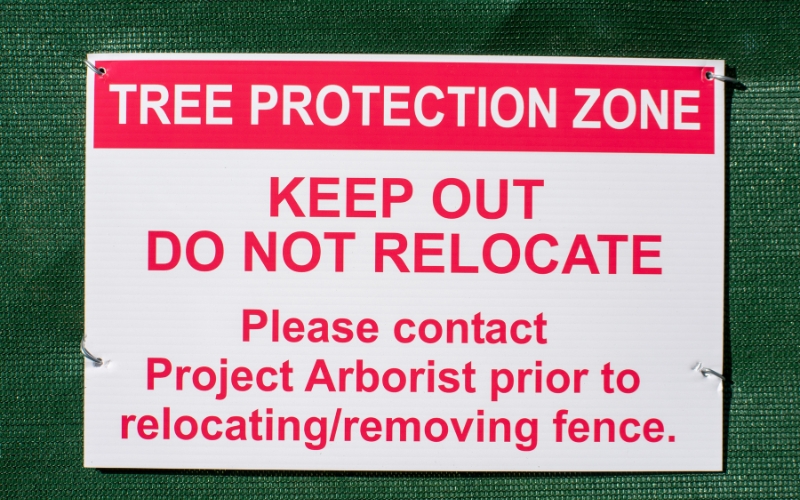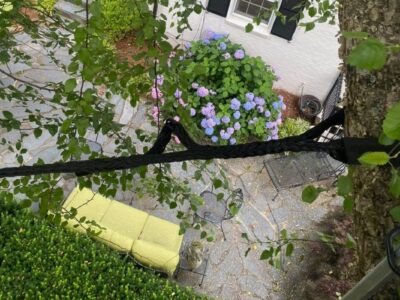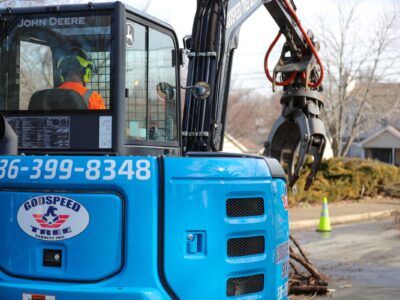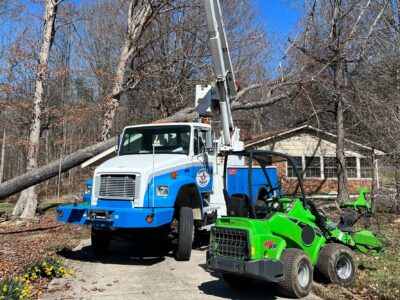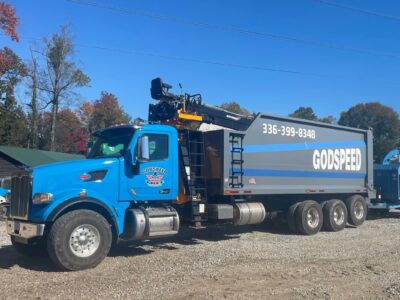5 Ways to Protect Trees from Construction Damage (And Why It’s Necessary)
June 19, 2024
Planning to build a home, add an extension, or install a pool in Winston-Salem and worried about construction damage to your trees? Learn how to keep your trees healthy during construction so you can enjoy them for years to come.
Whether you’re building your dream house on a nice piece of property tucked away in the woods or considering the perfect addition to create even more space to enjoy in your existing Winston-Salem home, there’s one thing you don’t want to overlook – your trees!
Construction projects can pose serious threats to your trees’ health. But, with a bit of planning and the right knowledge, you can ensure your trees not only survive the construction process but thrive for years to come.
Key Takeaways: What to Know About Tree Protection During Construction
- Trees provide many benefits to our Winston-Salem community, including enhancing property values, managing stormwater, improving air quality, naturally cooling the air, and providing habitats for our wildlife.
- Construction activities can damage trees through root disruption, soil compaction, physical injuries to their trunks and branches, grade changes in the soil, and chemical exposure.
- Contact a certified arborist before construction begins so they can help prune strategically, create a tree protection zone, and maintain the health of your trees throughout the entire construction process.
Why Protect Your Trees During Construction?
Protecting your trees from damage during construction isn’t just about maintaining your privacy or helping the environment, although those are fantastic benefits. Those oaks, maples, dogwoods, or pine trees (North Carolina’s very own state tree) in your yard are valuable assets that extend far beyond just looking nice. Here are just a few ways trees impact our lives:
- Healthy Trees Enhance Property Values: Studies show mature trees can increase your property value by thousands of dollars. Healthy, established trees add undeniable curb appeal and a sense of maturity to your property, increasing your home’s value. Don’t let construction erase that investment!
- Trees Help Manage Stormwater: A tree’s extensive root system helps absorb rainwater, prevent soil erosion and flooding, and even help manage stormwater runoff. That’s why, in Winston-Salem, where heavy rains can occur throughout the year, we need healthy trees that allow water to infiltrate the ground slowly, replenishing groundwater supplies and reducing the strain on storm drains.
- Trees Improve Air Quality: Trees act as nature’s air filters, removing pollutants like dust, smoke, and harmful gases from the air we breathe. In urban areas, where air quality can be a concern, trees are essential in improving air quality, reducing respiratory problems, and creating a healthier community.
- Air is Naturally Cooled Around Trees: Through evapotranspiration, leaves also release water vapor into the atmosphere, which absorbs heat from the surrounding air. This creates a cooler microclimate under the tree, sometimes as much as 6 degrees cooler than the surrounding air temperatures. Trees around your home can lower your cooling bills by up to 30%, a significant savings during our hot and humid summers.
- Trees Provide Wildlife Habitat: From birds and small animals to butterflies and other insects, trees provide a vital habitat for a diverse range of wildlife. They offer food, shelter, and nesting sites for countless creatures, creating a thriving ecosystem in our little portion of North Carolina.
How Construction Projects Can Damage or Kill Trees
While construction brings the excitement of your dream home taking shape, you’d be shocked by how vulnerable trees are to the disruptions caused by all the commotion. Here are a few hidden dangers that are lurking within a construction zone:
Root System Disruption
The roots of a tree are its lifeline. Most people are surprised to discover that a tree’s roots extend far beyond what we call the dripline, or the area beneath the outermost branches. Excavation for foundations, driveways, and utilities can sever roots, impacting the tree’s ability to absorb water and nutrients. When structural roots are cut, trees become unstable and more likely to topple during windy weather or a heavy downpour.
Soil Compaction
Heavy construction machinery can compact the soil around a tree’s roots. This reduces air and water infiltration, hindering root growth and oxygen flow. Compacted soil can lead to root suffocation, lack of oxygen, and even inhibit the tree from absorbing vital water and nutrients.
Physical Injuries
Accidents happen! But bumps, cuts, and scrapes on a tree’s trunk and limbs left by construction equipment and tools can leave a tree vulnerable to diseases and insect infestation. Deep gashes, torn bark, broken branches, and cracks in the trunk or major branches can also impact the tree’s structural integrity, leaving it prone to failure.
Changes in Grade
Altering the soil level around a tree, either by adding or removing significant amounts of soil, can disrupt the root system and impact drainage. This can lead to root rot, decline, and even tree death.
Chemical Exposure
If all building debris and chemical waste aren’t hauled away for proper disposal, those chemicals could leak into the soil. Many of these chemicals are toxic to tree roots, hindering their ability to function properly and ultimately affecting the health of the entire tree.
5 Ways You Can Protect Your Trees During Construction
As our city grows, development can sometimes come at the expense of trees. To protect these valuable assets, Winston-Salem has urban forestry ordinances in place.
The good news is that even with construction, you can minimize damage to your trees – especially historic ones! Here are a few strategies to keep your trees alive and thriving throughout the construction process.
#1. Plan Ahead
The key to avoiding unnecessary tree damage is to develop a tree protection plan at the very beginning that prioritizes the trees you’d like to save. This might involve adjusting your layout to avoid mature trees on your property or incorporating courtyards and patios into your original design to prevent building foundations from being built too close to valuable trees.
#2. Prune Branches Before They Get in the Way
There are some situations where tree trimming might be necessary to protect your trees and ensure the safety of others during the building process. This should be done before construction work begins.
For example, tree limbs that are directly in the way of moving equipment or branches that are dead or heavily diseased can pose a safety risk for construction workers. A Winston-Salem certified arborist can assess the situation and remove specific branches to create proper clearance while minimizing the impact on the tree’s overall health.
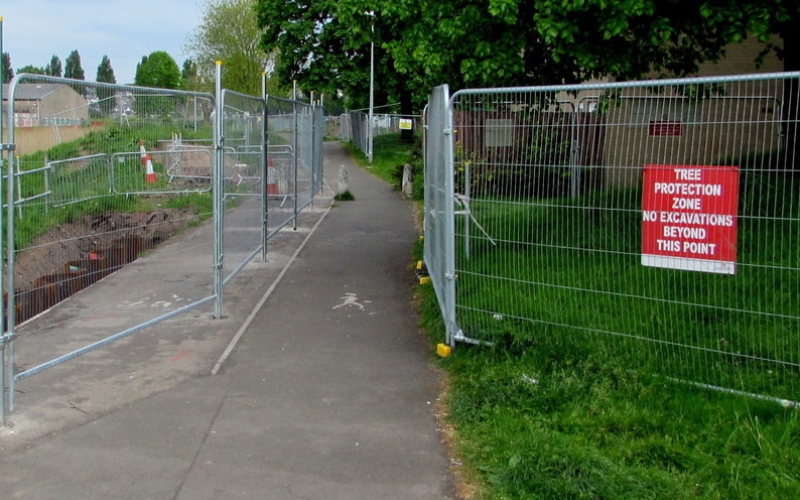
Tree protection zone keeps construction activities away from mature trees.
#3. Create a Tree Protection Zone (TPZ)
A tree protection zone is a designated area around your tree that acts as a safety zone, minimizing disruption and protecting the root system. The size of this protection zone depends on the species and size of your tree. An arborist will be able to determine the area that needs to be protected. Fair warning though – it will likely be larger than you expect.
Once you’ve determined your TPZ, mark the perimeter clearly with bright fencing and colorful flags. “Keep Out” signs will let everyone know not to move the fencing or store construction materials inside the tree protection zone.
Be sure to review the plan with your general contractor or construction manager to ensure their crew members all understand what the TPZ is and will respect its boundaries.
#4. Protect the Root System
A tree’s roots develop and survive where there is adequate oxygen and moisture. Most active roots are in the top 3 feet of soil, with most of them within the top 12 inches.
If any digging must be done near the base of a tree in a construction area, opt for hand tools or an air spade instead of picks and shovels. This allows for more precise excavation around sensitive roots, minimizing accidental damage to your tree.
#5. Give Your Trees a Little TLC
Construction can be a stressful time for everyone, and your trees are no exception. Regularly monitor your trees and contact your local arborist if you notice any sudden signs of distress, such as wilting leaves, discoloration, or excessive leaf drop. You can also add a layer of organic mulch around the base of your tree to retain moisture in the soil, keep soil cool in summer, and suppress weeds. And, if Winston-Salem is experiencing a particularly hot and dry period, provide your tree with regular deep watering to keep it well hydrated.
PRO TIP – Check your irrigation system at least weekly during construction projects. We’ve seen many valued trees die simply because an irrigation line was accidentally cut or damaged by heavy equipment.
Protect Your Trees While Building Your Dream – Call Godspeed Today!
Building your dream home, adding an extension, or installing a pool doesn’t have to be a battle against nature, and it shouldn’t mean sacrificing the very things that make your property so charming. The sooner you contact an ISA certified arborist, the higher the chances are that you can avoid tree damage during construction.
The certified arborists at Godspeed Tree Service can help create a plant health care program that will monitor and treat stress, diseases, and insect infestations throughout all phases of construction. With more than 25 years of experience caring for trees in and around Winston-Salem, we are confident your trees will not only survive but thrive for generations to come!
Don’t let construction projects interfere with the health of your trees. Call Godspeed Tree Service today at 336-399-8348 to speak with us directly or fill out our online form to request a quote.

Godspeed Tree Service
Owned and operated with high standards and consistent reliability by Bobby Gates, Godspeed Tree Service has earned the trust of the North Carolina Triad community over the course of more than 25 years in business. With a strong emphasis on safety, conscientious training, and accommodating the needs of each client, you can't go wrong by hiring Godspeed for any of your tree service needs!
